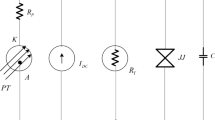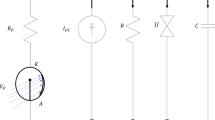Abstract
A brand-new photochemical oscillator is designed in this work. It consists of two thermally reversible photochromic compounds. One photochrome is inverse and autocatalytic because the photoproduct emits a fluorescence that enhances its own production. The other photochrome is direct and not fluorescent. The two photochromes have specific spectral features that generate mutual filter effects when dissolved in the same solution and under uniform irradiation. The double photochromic system can originate photochemical oscillations if an essential condition is fulfilled. The autocatalytic photochromic compound must have its photochemical quantum yield and thermal recovery kinetic constant appreciably larger than the other photochrome. The conditions favorable for having photochemical oscillations are quantitatively described. This new photochromic oscillator, working in isothermal conditions, is an alluring model of pacemaker neurons, which can communicate with other artificial neuron models through optical signals. It constitutes a valuable contribution to the development of neuromorphic engineering in wetware. Its characteristics and performances are compared with those of the other photochromic oscillator that has been proposed so far.








Similar content being viewed by others
Data availability
Not applicable.
Code availability
Not applicable.
References
Albus JS, Bekey GA, Holland JH, Kanwisher NG, Krichmar JL, Mishkin M, Modha DS, Raichle ME, Shepherd GM, Tononi G (2007) A proposal for a decade of the mind initiative. Science 317:1321
Jeon J, Suh Y (2017) Analyzing the major issues of the 4th industrial revolution. Asian J Innov Policy 6:262–273
Gentili PL (2018) Untangling Complex Systems: A Grand Challenge for Science. CRC Press, Boca Raton
Gentili PL (2021) Why is complexity science valuable for reaching the goals of the UN 2030 agenda? Rend Fis Acc Lincei 32:117–134. https://doi.org/10.1007/s12210-020-00972-0
Russell SJ, Norvig P (2009) Artificial Intelligence. A Modern Approach. Prentice-Hall NJ, USA
Mead C (1989) Analog VLSI and Neural Systems. Addison-Wesley, MA, USA
Donoghue JP (2008) Bridging the brain to the world: a perspective on neural interface systems. Neuron 60:511–521. https://doi.org/10.1016/j.neuron.2008.10.037
Indiveri G (2021) Introducing “Neuromorphic Computing and Engineering.” Neuromorph Comput Eng 1:010401. https://doi.org/10.1088/2634-4386/ac0a5b
Zhu Y, Zhu Y, Mao H, He Y, Jiang S, Zhu L, Chen C, Wan C, Wan Q (2022) Recent advances in emerging neuromorphic computing and perception devices. J Phys D: Appl Phys 55:053002. https://doi.org/10.1088/1361-6463/ac2868
Izhikevich M (2007) Dynamical systems in neuroscience. MIT Press, Cambridge, MA
Rabinovich MI, Varona P, Selverston AI (2006) Dynamical principles in neuroscience. Rev Mod Phys 78:1213–1265
Service RF (2014) The brain chip. Science 345:614–616
Merolla PA, Arthur JV, Alvarez-Icaza R, Cassidy AS, Sawada J, Akopyan F, Jackson BL, Imam N, Guo C, Nakamura Y, Brezzo B, Vo I, Esser SK, Appuswamy R, Taba B, Amir A, Flickner MD, Risk WP, Manohar R, Modha DS (2014) A million spiking-neuron integrated circuit with a scalable communication network and interface. Science 345:668–673
Ha SD, Ramanathan S (2011) Adaptive oxide electronics: a review. J Appl Phys 110:071101
Di Ventra M, Pershin YV (2013) The parallel approach. Nat Phys 9:200–202
Pilarczyk K, Podborska A, Lis M, Kawa M, Migdal D, Szacilowski K (2016) Synaptic behavior in an optoelectronic device based on semiconductor-nanotube hybrid. Adv Electron Mater 2:1500471. https://doi.org/10.1002/aelm.201500471
Tuma T, Pantazi A, Le Gallo M, Sebastian A, Eleftheriou E (2016) Stochastic phase-change neurons. Nat Nanotechnol 11:693–699
Lee Y, Lee T-W (2019) Organic synapses for neuromorphic electronics: from brain-inspired computing to sensorimotor nervetronics. Acc Chem Res 52:964–974. https://doi.org/10.1021/acs.accounts.8b00553
Adamatzky A, De Lacy CB, Asai T (2005) Reaction–diffusion computers. Elsevier, New York, NY, USA
Gentili PL (2013) Small steps towards the development of chemical artificial intelligent systems. RSC Adv 3:25523–25549. https://doi.org/10.1039/C3RA44657C
Gentili PL, Giubila MS, Germani R, Romani A, Nicoziani A, Spalletti A, Heron BM (2017) Optical communication among oscillatory reactions and photo-excitable systems: UV and visible radiation can synchronize artificial neuron models. Angew Chem Int Ed 56:7535–7540. https://doi.org/10.1002/anie.201702289
Gentili PL, Giubila MS, Germani R, Heron BM (2018) Photochromic and luminescent compounds as artificial neuron models. Dyes Pigm 156:149–159. https://doi.org/10.1016/j.dyepig.2018.04.006
Vanag V (2019) Hierarchical network of pulse coupled chemical oscillators with adaptive behavior: chemical neurocomputer. Chaos 29:083104. https://doi.org/10.1063/1.5099979
Litschel T, Norton MM, Tserunyan V, Fraden S (2018) Engineering reaction–diffusion networks with properties of neural tissue. Lab Chip 18:714–722. https://doi.org/10.1039/C7LC01187C
Bartolomei B, Heron BM, Gentili PL (2020) A contribution to neuromorphic engineering: neuromodulation implemented through photochromic compounds maintained out of equilibrium by UV–visible radiation. Rend Fis Acc Lincei 31:39–52. https://doi.org/10.1007/s12210-020-00869-y
Okamoto H, Tanaka N, Naito M (1995) Analogy between the stimulus-response characteristics of neuronal and electrochemical cells. Chem Phys Lett 237:432–436. https://doi.org/10.1016/0009-2614(95)00336-3
Liu Y, Sebek M, Mori F, Kiss IZ (2018) Synchronization of three electrochemical oscillators: from local to global coupling. Chaos 28:045104. https://doi.org/10.1063/1.5012520
Gentili PL, Micheau J-C (2020) Light and chemical oscillations: Review and perspectives. J Photochem Photobiol C 43:100321. https://doi.org/10.1016/j.jphotochemrev.2019.100321
Gentili PL, Horvath V, Vanag VK, Epstein IR (2012) Belousov-Zhabotinsky “chemical neuron” as a binary and fuzzy logic processor. Int J Unconv Comput 8:177–192
Horvath V, Gentili PL, Vanag VK, Epstein IR (2012) Pulse-coupled chemical oscillators with time delay. Angew Chem Int Ed 51:6878–6881. https://doi.org/10.1002/anie.201201962
Gentili PL, Bartolomei B, Micheau J-C (2021) Light-driven artificial neuron models based on photoswitchable systems. Dyes Pigm 187:109086. https://doi.org/10.1016/j.dyepig.2020.109086
Gentili PL, Dolnik M, Epstein IR (2014) “Photochemical oscillator”: Colored hydrodynamic oscillations and waves in a photochromic system. J Phys Chem C 118:598–608. https://doi.org/10.1021/jp407393h
Gentili PL, Gotoda H, Dolnik M, Epstein IR (2015) Analysis and prediction of aperiodic hydrodynamic oscillatory time series by feed-forward neural networks, fuzzy logic, and a local nonlinear predictor. Chaos 25:013104. https://doi.org/10.1063/1.4905458
Hayashi K, Gotoda H, Gentili PL (2016) Probing and exploiting the chaotic dynamics of a hydrodynamic photochemical oscillator to implement all the basic binary logic functions. Chaos 26:053102. https://doi.org/10.1063/1.4948590
Boissonade J, De Kepper P (1980) Transitions from bistability to limit cycle oscillations. Theoretical analysis and experimental evidence in an open chemical system. J Phys Chem A 84:501–506. https://doi.org/10.1021/j100442a009
Borderie B, Lavabre D, Micheau JC, Laplante JP (1992) Nonlinear dynamics, multiple steady states, and oscillations in photochemistry. J Phys Chem 96:2953–2961. https://doi.org/10.1021/j100186a035
Gentili PL, Rightler AL, Heron BM, Gabbutt CD (2016) Extending human perception of electromagnetic radiation to the UV region through biologically inspired photochromic fuzzy logic (BIPFUL) systems. Chem Commun 52:1474–1477. https://doi.org/10.1039/C5CC09290F
Gentili PL, Rightler AL, Heron BM, Gabbutt CD (2016) Discriminating between the UV-A, UV-B and UV-C regions by novel Biologically Inspired Photochromic Fuzzy Logic (BIPFUL) systems: A detailed comparative study. Dyes Pigm 135:169–176. https://doi.org/10.1016/j.dyepig.2016.02.034
Cervellati R (2021) William Crowell Bray and the discovery of the first periodic homogeneous reaction in 1921. Reac Kinet Mech Cat. https://doi.org/10.1007/s11144-021-02019-3
Funding
This research was not supported by any external grant.
Author information
Authors and Affiliations
Corresponding author
Ethics declarations
Conflict of interest
The authors have no competing interests and conflicts of interest to declare.
Additional information
Publisher's Note
Springer Nature remains neutral with regard to jurisdictional claims in published maps and institutional affiliations.
Supplementary Information
Below is the link to the electronic supplementary material.
Rights and permissions
About this article
Cite this article
Gentili, P.L., Baldinelli, L. & Bartolomei, B. Design of a new photochromic oscillator: towards dynamical models of pacemaker neurons. Reac Kinet Mech Cat 135, 1281–1297 (2022). https://doi.org/10.1007/s11144-021-02122-5
Received:
Accepted:
Published:
Issue Date:
DOI: https://doi.org/10.1007/s11144-021-02122-5




